Jake’s First Ride West
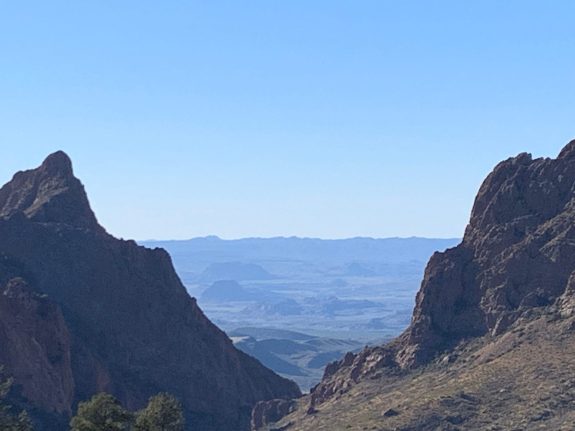
By James Moore
“We need the tonic of wildness. At the same time that we are earnest to explore and learn all things, we require that all things be mysterious and un-explorable, that land and sea be indefinitely wild, un-surveyed and unfathomed by us because it is unfathomable. We can never have enough of nature.” – Thoreau
I once rode up to the headwaters of two rivers in one day. Motorcycles can simplify such accomplishments. The Guadalupe I knew well and had traveled much of its length in a canoe and raft, and I had seen it in a fierce flood that had taken innocent lives. Upstream where the river moves placidly over shining limestone beds it is not easy to imagine murderous rushes of water leaving float piles of debris a hundred feet up in the branches of an ancient cypress, but it is not uncommon.
Riding over the low water crossings of the river on my way west I was still unable to imagine such flooding. The Guadalupe is a languorous, spring-fed flow that offers mostly shallow pools and views to clear, stony bottoms. The crystalline reflection of a spring sun was almost blinding but offered no evidence nature might wrest such a tragedy from such an idyllic setting.
The big BMW motorbike was nearly as silent as a trickling river and took me up a slow rise to a box canyon that had long ago birthed another river. A visitor follows the water back up to a limestone cliff where hundreds of springs leak from the rock and gather into a flow that becomes the Frio River. Once known to beer marketers as the “Land of 1100 Springs,” a 10,000-acre ranch was worked along these headwaters by descendants of Stephen F. Austin’s sister.
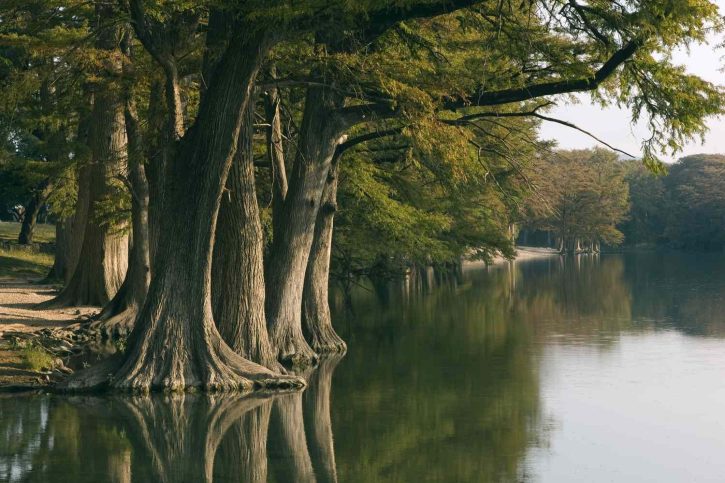
The Frio River
Oma Bell Perry, who had never married, and her sister, deeded the land over to Gary Priour, the poet-philanthropist who has devoted his adult life to raising children broken by unfair circumstances of their birth. Invisible hands, Priour has always claimed, guide his work, and when visitors see children playing in the water beneath the Texas sun, they understand why the ranch’s location is now referred to as “The Canyon of Angels.”
The highway through Frio Canyon unspools from the hill country twists to an easy run toward Uvalde. The hills are almost Irish green and treed with live oak and cottonwood and the tall cypress that always find the water. I slow the bike and stop for pictures without thinking I might be keeping a friend waiting down on Highway 90. Leakey and Utopia, dreamy little country towns, demand lingering but I pass through as quickly as though I were watching a movie and roll the throttle up.
Jake and I connect and move in the direction of the sun, riding parallel to the Rio Grande. His bike shines and rumbles in the southwestern glare as we get west of Del Rio. The sky must be as clear and blue as the day the world began to spin. Bluebonnets and paint brush spread out over the rocky hills and color the desert. Water from Lake Amistad is backed up into what ought to be dusty arroyos that have been transformed into canals and waterways that are settings for large vacation homes owned by wealthy Mexicans. The vistas are improbable after the urban franchise sprawl of Del Rio, an unusual border town that is surrendering to American homogenization.

Highway 505, South Toward Mexico
Jake is an excitable boy in his 70s and cannot wait for the Davis Mountains to rise in front of us. He has spoken vaguely about cross country motorcycle rides but I am not certain he has experience with longer trips. His enthusiasm suggests this is certainly the first time he has gotten on two wheels for a run to the Texas Trans Pecos. Always energized by this ride, I am, nonetheless, affected by Jake’s garrulousness on our stops and become enamored anew with familiar sights. Being a lobbyist in the state capitol and living in the tropical Rio Grande Valley has kept him from such scenery most of his life.
The sky gets bigger and consumes the countryside. We catch glimpses of Lake Amistad between the low mesas until U.S. 90 points down toward a river bridge. The Pecos, rarely much wider than a city sidewalk, has cut a deep canyon on approach to the lake. Water appears to be hardly moving but from above it is clear and shimmering in the breeze. The watercourse of the Pecos, which is mostly through the arid ranch country along the eastern perimeter of the Chihuahua Desert, has made it one of the most disputed water sources in the civilized world. Thousands of years before we motored across the river, indigenous peoples lived in the canyon below, possibly some of the first in North America, and they have left stone paintings and petroglyphs on the walls of caves and rock overhangs down where the Pecos meets the dammed up Rio Grande.

Pecos River Canyon
There are still lawsuits over the diversion and consumption of the Pecos and when you stand on its bank and taste the sweetness of the water in 100-degree heat, surrounded by rock, sand, and cactus, you understand why it has been treated as sacred by every human who has lived within its watershed. Encircled by ocotillo and pinon and cholla in the rising spring heat and staring down at the Pecos from the bridge, I end up thinking about the delta down on the Gulf Coast where the Old and the Lost River sweeps to the sea. Those two waterways always have looked to me as though they have the capacity to slake the thirst of all eight billion souls on board our little ship even as we shoot at each other across a stream like the Pecos.
The world continues to confound me.
When the road levels out farther west, we see the green and white Border Patrol vehicles dragging tires behind them on a long rope. A dirt track has been bladed beside the highway beyond the bar ditch and up next to the fence line. The dusty line runs west to Sanderson and then beyond toward Marathon and Van Horn and there are several of the government SUVs pulling tires and covering their tracks.
Unless you know the border, there is no context for such an absurd endeavor. River crossers with the right gear and water and food often come to these remote spots to enter the U.S. They are sometimes carrying backpacks with marijuana or other “contradbando,” but mostly they are just determined spirits that believe they can survive anything if they just get to America. The soil itself holds a magic for them. They are often wrong, though. The Border Patrol drags the dirt to make footprints visible and to know where to go to capture the transgressor.
“Seems to me we ought to want those guys here,” I heard an acquaintance say over breakfast in Marathon. “Anybody gets that far; they are pretty damned determined and might be useful in a country like ours.”
There were just Jake and I at a nearby table, each with a full head of hair, and not a single strand showed any color. We only looked like we might have a touch of wisdom. Such a judgment was only marginally accurate.
“Just seems to me like an insane waste of money,” I said, aware that we had both overheard the nearby conversation. “Doesn’t appear to offer much of a return on investment by catching a few pounds of marijuana or the lone border runner.”
“Well, Jimmy, we don’t have much say about it either way,” Jake said. “It’s just the way it is along that river.”
“They’ve been doing that drag and detect foolishness since I was a kid,” the man at the other table said, having picked up our exchange. “No way of knowing if it’s effective.”
“It’s effective at spending government tax money and keeping people employed,” I told him. “And I suspect that’s what matters more than few pounds of pot being confiscated. Makes politicians feel better, too. Secure the border!!”
Jake and I sped south toward the national park after breakfast and watched the clouds shred themselves on the Glass Mountains. The sky above was clear and blue but the pretty people on the motel TV had said rain was likely before sundown. I was skeptical as we began the sharp climb up to the Chisos Basin a few hours later because we stopped and looked behind us to the north and the air was pure enough to almost make visible McDonald Observatory about 150 miles distant.
The park road curled so sharply it almost felt as if it were twisting back onto itself and we slowly rose to altitude past the signs warning about bears and panthers. The ancient world was visible from up there and looking through “The Window” that opened up between two mountains at the desert floor, I had no trouble imagining great prehistoric species stalking the far plains along the shores of ancient, inland seas.
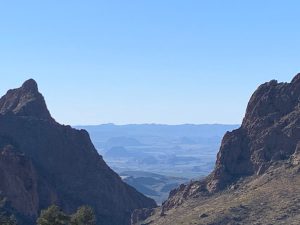
The Window, Chisos Basin, Big Bend National Park
We ended up on the porch of the general store in Terlingua, a ghost town that thrived briefly during a global demand for mercury. There is now the little store and the Starlight Restaurant and rustic adobes turned into pricey bed and breakfast establishments. A few cantinas and burger joints are along the bumpy road up the hill. The predominant feature, though, is the graveyard with Spanish surnames cut crudely into stone or desiccated wood crosses, many of them tilted by weather and time.
I went to the icebox in the general store and got two Tecates and came back out to sit on the bench that spans the front of the building and looks out over the long slope back to the river. The Chisos cut a ragged line across the horizon as we looked eastward toward the park and leaned against the wall to talk with the assembled strangers.
“Where’d you two ride from?”
The question was from a young man in a dirty baseball cap, jeans, and work boots. His dark tee shirt was sweated through and dirty but it was not torn.
“Different places. Austin and the Rio Grande Valley,” I said.
“I need to get to Austin some day,” he said. “But it’s just another big, corporate city now, I suppose.”
“There’s more than just a touch of that, for sure,” I said. “Whatever we used to like about it thirty years ago is slipping away. Where are you from?”
“Oh, Connecticut.”
“Really? What in the hell got you out here?”
“I just wanted to get as far away from corporate bullshit as I could and this looked like the best spot on the map.”
“You don’t look old enough to be fed up with climbing the corporate ladder.”
He cut his eyes at me but then smiled. “Well, I am. I hated it. I had a good job. But it was all politics and caring about shit that seemed pretty stupid to me. Out here, I work when I want, do what I want, and nobody cares what I think or do.”
“I guess that’s worth more than a corporate salary.”
“It is,” he said, and then pointed to the Chisos. “The light at the end of the day on those ranges never gets old to me. Ain’t it funny? This is probably the only place in America where people come to sit and see the sunset by looking east at those mountains.”
The people who live in the desert around the ghost town all have a story about wanting to be away from the world. They move up into the remote stretches and build adobes and survive off the grid but never have to impress another human or answer any questions. I have met government agents and truck drivers and drug runners sitting the sun on that general store porch and they all view privacy as Terlingua’s most precious commodity.
We got back on the bikes and went north toward Alpine. Crossing deserts on a motorcycle always leaves me with a sense that even the most mundane human act takes on epic proportions. Closing a door or simply walking across a street feels like it has a connectedness to some grander endeavor, which cannot immediately be known. This is mostly delusional, I suppose, but no one ever seems to simply watch the rain as it falls after a storm arrives in a desert; they appear to be battling the elements before an incomprehensible backdrop. I have ridden across the Mojave, Sonoran, and Chihuahua deserts many times and up and down the Great Basin and have always expected the universe to reveal secrets as the road endlessly extends.
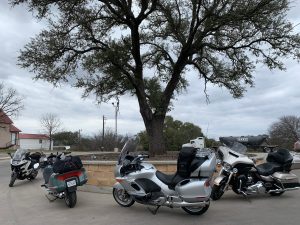
More than an hour out of Alpine we had ridden under a black sky and left the sun shining behind us on the canyons of the Rio Grande. Lightning shot across our view in sharp-edged bolts and the thunderclaps were disturbing even above the wind and engine noise. When we rode into the rain, we were drenched in minutes, and as we came over each rise I looked to the north for a break in the sky and a furtive hope our destination might yet be dry.
Curtains of rain hung over the high mesas to our east and the inky black in some parts of the cloud cover faded to gray. Rain sways as belts in the far wind. Immediately, small breaks appeared in the storm and the sun found a few white basalt hills and dried out ranges and illuminated them in the afternoon darkness. A spotlight was cast across our front and onto a scene as old and eroded as it can be made by time and the elements. The show was almost more than could be imagined because the light and the dark and the rain and the desert offered such contrasts in microcosm.
“I prayed all the way through that storm, Jimmy,” Jake said later. “I got us some good mojo.”
We are eating thick steaks at the Reata and trying to dry out over dinner. Friday night was working hard to be exciting outside in Alpine.
“I guess you got us some magic then, Jake. Here we are. Wet but alive. And you’ll remember that stretch of Texas highway, I bet.”
“Yeah, but let’s not do that again real soon, pardner.”
“Let’s see what the ride looks like back to Marathon.”
The storm was rolling east as we ate, and we lingered to give it time enough to pass but as we went back down U.S. 90 the lightning lit our way. We did not hear thunder, but the cell was curling back on its own cloud tops and peeling away toward Del Rio, leaving great flashes of light across the night as it receded. We slowed enough to let the weather guide us down the road, but we were still surrounded by momentary brightness and daggers of light that seemed like cannon shot and were frequent enough that they might eventually find their targets.
We had dined also the day previous in Marfa at the old Paisano Hotel, and I was confident the ghosts of Liz Taylor, Rock Hudson, James Dean, and Dennis Hopper were shuffling the halls looking for their rooms and wondering what had happened to the desert ranch town they had left behind after filming Edna Ferber’s “Giant.” I worried greatly about the monsoon and lightning also turning us into something incorporeal.

Almost biblical rain had fallen in Marathon by the time we parked our bikes. Six to eight inches running across the rock and finding the dry arroyos, eventually reaching the Rio Grande.
Jake took off his helmet and smiled in the dim light from the cabins. “Got ya more mojo there, too, brother. Kept ya safe all the way in.”
“Yep, you are, from here on, Lightnin’ Jake.”
The magical desert sky and the western landscapes had fooled me yet again. And made me believe we were immortal.

Jacob Fuller, Dec. 1940 – Mar. 2024 RIP
This article was originally published on Texas to the world.
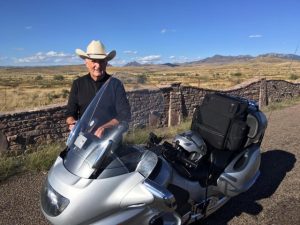
James Moore is the New York Times bestselling author of “Bush’s Brain: How Karl Rove Made George W. Bush Presidential,” three other books on Bush and former Texas Governor Rick Perry, as well as two novels, and a biography entitled, “Give Back the Light,” on a famed eye surgeon and inventor. His newest book will be released mid- 2023. Mr. Moore has been honored with an Emmy from the National Academy of Television Arts and Sciences for his documentary work and is a former TV news correspondent who has traveled extensively on every presidential campaign since 1976.
He has been a retained on-air political analyst for MSNBC and has appeared on Morning Edition on National Public Radio, NBC Nightly News, Last Word with Lawrence O’Donnell, CBS Evening News, CNN, Real Time with Bill Maher, and Hardball with Chris Matthews, among numerous other programs. Mr. Moore’s written political and media analyses have been published at CNN, Boston Globe, L.A. Times, Guardian of London, Sunday Independent of London, Salon, Financial Times of London, Huffington Post, and numerous other outlets. He also appeared as an expert on presidential politics in the highest-grossing documentary film of all time, Fahrenheit 911, (not related to the film’s producer Michael Moore).
His other honors include the Dartmouth College National Media Award for Economic Understanding, the Edward R. Murrow Award from the Radio Television News Directors’ Association, the Individual Broadcast Achievement Award from the Texas Headliners Foundation, and a Gold Medal for Script Writing from the Houston International Film Festival. He was frequently named best reporter in Texas by the AP, UPI, and the Houston Press Club. The film produced from his book “Bush’s Brain” premiered at The Cannes Film Festival prior to a successful 30-city theater run in the U.S.
Mr. Moore has reported on the major stories and historical events of our time, which have ranged from Iran-Contra to the Waco standoff, the Oklahoma City bombing, the border immigration crisis, and other headlining events. His journalism has put him in Cuba, Central America, Mexico, Australia, Canada, the UK, and most of Europe, interviewing figures as diverse as Fidel Castro and Willie Nelson. He has been writing about Texas politics, culture, and history since 1975, and continues with political opinion pieces for CNN and regularly at his Substack newsletter: “Texas to the World.”
Like what we do at The AIMN?
You’ll like it even more knowing that your donation will help us to keep up the good fight.
Chuck in a few bucks and see just how far it goes!
Your contribution to help with the running costs of this site will be gratefully accepted.
You can donate through PayPal or credit card via the button below, or donate via bank transfer: BSB: 062500; A/c no: 10495969











1 comment
Login here Register here-
Harry Lime
Return to home pageMoving story, moving imagery,spectacular landscape.